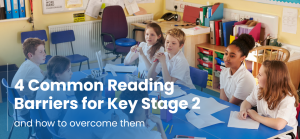Reading is a cornerstone of learning, yet many primary pupils encounter challenges that can prevent them from achieving proficiency. Addressing these obstacles requires both targeted interventions and fresh approaches that go beyond ‘more of the same’. In this post, we’ll explore four common barriers to reading growth in Key Stage 2 pupils and share strategies for overcoming them.

1. Stalling Progress with ‘More of the Same’ Approaches
For some pupils, traditional classroom strategies simply aren’t enough. This is especially true in Key Stage 2, where struggling readers may have fallen behind despite prior intervention. Without fresh approaches, these pupils risk continuing to lag further behind their peers.
How to Overcome This:
Teachers can support pupils by shifting to strategies that revisit and rebuild foundational skills while introducing engaging, differentiated instruction. Look for programs that identify gaps in learning and offer personalised, adaptive pathways to mastery. These approaches ensure that pupils aren’t stuck repeating methods that haven’t worked for them.
An effective solution should provide both students and teachers with a renewed approach—offering a way to re-engage pupils with targeted, manageable steps toward progress. Consider using technology to track mastery and provide immediate feedback, making the learning process more transparent and motivating for pupils.
2. The Challenge of Catching Up and then Keeping up
Many struggling readers in Key Stage 2 are expected to both “catch up” on missed Key Stage 1 skills and then “keep up” with increasingly complex content in upper school. Balancing these demands is challenging for both pupils and teachers.
How to Overcome This:
Effective catch-up strategies focus on identifying and targeting the specific gaps from Key Stage 1 that continue to hold pupils back. Diagnostic assessments can pinpoint which phonics, fluency, or comprehension skills need reinforcement. In addition, it’s crucial to then scaffold Key Stage 2 learning to ensure pupils can access age-appropriate texts and deepen their understanding of content.
Building comprehension and vocabulary skills in tandem with decoding skills provides a holistic approach to literacy development. A structured approach that integrates both catch-up and keep-up strategies ensures no time is wasted and that pupils remain on track to transition to secondary school as confident readers.
3. Ensuring Equity in Literacy Growth
Disadvantaged pupils are often disproportionately affected by literacy gaps, and traditional approaches may not address these needs effectively at the scale required. Teachers need solutions that ensure all pupils, regardless of their starting point, have access to equitable literacy instruction.
How to Overcome This:
Innovative use of technology can level the playing field, offering consistent, personalised instruction to every pupil. Research-backed adaptive programs adjust to each pupil’s needs, helping disadvantaged learners catch up and make real progress, even when resources are limited.
Additionally, focusing on growth milestones rather than simply meeting age-related standards can help build confidence and momentum for struggling readers. Providing regular opportunities to celebrate small victories encourages persistence and motivates pupils to continue improving.
4. Navigating the Overload of Literacy Strategies
With countless literacy programs and interventions available, it can be overwhelming to decide which approaches will truly benefit pupils. Many programs claim to be “research-based,” but there is an important distinction between being “research-based” and “research-proven.” Without clarity on the difference, teachers may invest valuable time and resources in strategies that lack evidence of effectiveness in real classrooms.
How to Overcome This:
To ensure pupils benefit from approaches that genuinely work, focus on strategies that are research-proven. These are programs that have undergone rigorous testing and evaluation, demonstrating measurable and consistent improvements in learning outcomes. A great place to start is the EEF Promising Programmes list, which highlights interventions backed by solid evidence.
When evaluating literacy programs, ask critical questions:
- Has the program been tested in settings like yours (e.g. primary schools)?
- Are the results of the research transparent and peer-reviewed?
- How significant were the outcomes, and were they sustained over time?
It’s also important to remember that even the best programs require effective implementation to succeed. Pairing research-proven interventions with professional development and ongoing teacher support will maximise their impact.
The Lexia Advantage
Lexia Core5 Reading is designed to help Key Stage 2 pupils overcome these common barriers, offering a truly fresh start for both learners and their teachers:
- A Renewed Approach Where “More of the Same” Isn’t Working: Core5 identifies and revisits Key Stage 1 skills not yet mastered, helping pupils catch up quickly while re-engaging them with reading in an enjoyable, age-appropriate way.
- Catch-Up and Keep-Up Strategies: Core5 ensures pupils master essential reading skills while continuing to develop comprehension and fluency. This dual focus prepares pupils for secondary school with the confidence and proficiency they need to succeed.
- Equitable and Achievable Progress for All Pupils: Proven to deliver results, particularly for disadvantaged pupils, Core5 uses innovative technology to provide personalised and impactful instruction on a larger scale.
- Designed for Teachers, by Teachers: Core5 empowers educators by providing detailed diagnostics and actionable insights, enabling precise and personalised teaching without adding to their workload.
- Research-Proven: Lexia Core5 Reading has undergone rigorous evaluation to ensure its impact on literacy outcomes is both measurable and meaningful. It is included in the EEF Promising Programmes list, highlighting its proven ability to accelerate progress, particularly for disadvantaged pupils. Unlike programs that are merely research-based, Core5 delivers evidence-backed results in real-world classrooms, giving teachers confidence that their efforts are making a genuine difference.
With Core5, teachers can provide targeted support that equips pupils to thrive as readers, all while making teaching more effective and time-efficient. It’s more than just a reading program—it’s a tool for closing gaps, fostering equity, and empowering educators.
